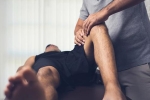Rehabilitation after an Osteochondral Allograft Transplantation to the Knee
Rehabilitation after an osteochondral allograft transplantation (OAT) for knee cartilage injuries is crucial for a successful recovery and return to full function. The optimal rehabilitation protocol should be individualized based on the patient’s specific condition, the size and location of the graft, and the surgeon’s preferences. Here’s a general outline of a rehabilitation protocol that is often used and considered effective:
Phase 1: Immediate Post-Operative (Weeks 0-6)
Goals
- Protect the graft and surgical site.
- Manage pain and swelling.
- Begin gentle range of motion (ROM) exercises.
Guidelines
- Weight Bearing: Non-weight bearing with crutches. Gradual progression to partial weight bearing as advised by the surgeon.
- Immobilization: Use of a knee brace locked in extension for the first few weeks. Gradual unlocking to allow for increased ROM.
- Pain Management: Use of ice, elevation, and prescribed medications.
- Range of Motion:
- Passive ROM exercises to achieve full extension and up to 90 degrees of flexion by week 2-4.
- Continuous passive motion (CPM) machine may be used to assist with ROM.
- Strengthening:
- Isometric quadriceps contractions.
- Straight leg raises.
- Ankle pumps to promote circulation.
Phase 2: Early Rehabilitation (Weeks 6-12)
Goals
- Continue to protect the graft.
- Increase ROM.
- Begin muscle strengthening and proprioception exercises.
Guidelines
- Weight Bearing: Progress to full weight bearing as tolerated, usually by weeks 8-10.
- Range of Motion:
- Achieve full ROM by the end of this phase.
- Continue passive and active-assisted ROM exercises.
- Strengthening:
- Begin closed kinetic chain exercises (e.g., mini squats, step-ups).
- Gradual introduction of stationary cycling with no resistance.
- Core strengthening and hip stabilization exercises.
- Proprioception: Start proprioceptive training, including balance exercises on stable surfaces.
Phase 3: Intermediate Rehabilitation (Weeks 12-24)
Goals
- Achieve full ROM and normal gait.
- Enhance muscular strength and endurance.
- Improve neuromuscular control and proprioception.
Guidelines
- Weight Bearing: Full weight bearing with normal gait.
- Range of Motion: Continue to maintain and improve full ROM.
- Strengthening:
- Increase intensity of closed kinetic chain exercises.
- Add resistance to stationary cycling.
- Introduce leg press and hamstring curls with low resistance.
- Progress to more advanced core and hip strengthening exercises.
- Proprioception:
- Progress to balance exercises on unstable surfaces (e.g., Bosu ball).
- Begin light agility drills (e.g., ladder drills).
Phase 4: Advanced Rehabilitation (Months 6-9)
Goals
- Restore full strength and endurance.
- Prepare for return to sports and high-level activities.
Guidelines
- Strengthening:
- Advanced resistance training with increased weights and repetitions.
- Plyometric exercises (e.g., jumping drills, box jumps).
- Sport-specific strength and conditioning exercises.
- Proprioception and Agility:
- Advanced balance training.
- Sport-specific agility drills.
- Cardiovascular Conditioning: Increase intensity and duration of cardiovascular exercises.
Phase 5: Return to Activity (Months 9-12)
Goals
- Safe return to sports and high-level activities.
- Continue to enhance strength, agility, and endurance.
Guidelines
- Functional Testing: Perform functional tests to assess readiness for return to sports (e.g., single-leg hop test, Y-balance test).
- Sport-Specific Drills:
- Gradual reintroduction to sport-specific drills and activities.
- Ensure adequate neuromuscular control and confidence in the knee.
- Maintenance: Continue a maintenance program to sustain strength, flexibility, and proprioception.
Monitoring and Adjustments
- Regular follow-up appointments with the surgeon and physical therapist to monitor progress and adjust the rehabilitation program as needed.
Summary
A successful rehabilitation protocol following an osteochondral allograft transplantation should be progressive and individualized. It typically involves five phases: immediate post-operative, early rehabilitation, intermediate rehabilitation, advanced rehabilitation, and return to activity. Each phase has specific goals and guidelines focusing on protecting the graft, restoring ROM, strengthening the muscles, improving proprioception, and gradually returning to high-level activities and sports. Regular monitoring and adjustments by healthcare professionals are essential to ensure optimal recovery and outcomes.







